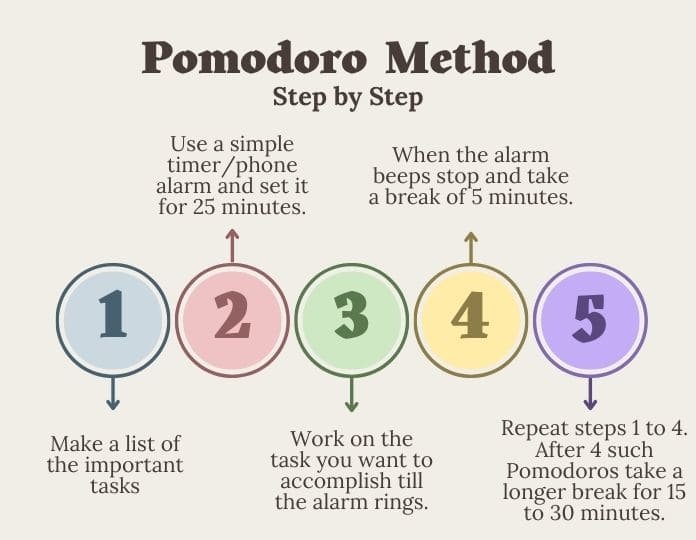How often have we given up looking at the exhaustive list of to-do things lined up for us, not knowing where to start? Yet, often have we thought the research project allotted as almost impossible and kept procrastinating to start it? How often have we felt we fell short of time for the tasks that seem to consume after all not so much time? Are you habituated to laying your hands on your mobile now and then aimlessly when in between a task, to check what’s app status updates, or Facebook posts without even knowing why? Well, if the answer is an affirmative this information is just for you!
Related: The Psychology of Procrastination: strategies to boost Productivity
What is the Pomodoro Technique?
Let me today introduce you to a technique, POMODORO. ‘A practical time management framework that helps avoid distractions and helps you productively focus on what task you put your hands into.” Why Pomodoro? Pomodoro is an Italian word for tomato. Francesco Cirillo who developed this method in the late 1980s named it Pomodoro because he used a kitchen timer shaped like a tomato as his personal Pomodoro timer.
Steps of the Pomodoro Technique

- STEP 1: Make a list of the important tasks you want to accomplish for the day.
- STEP 2: Use a simple timer/phone alarm and set it for 25 minutes.
- STEP 3: Work on the task you want to accomplish till the alarm rings. Each session of 25 minutes is called a Pomodoro.
- STEP 4: When the alarm beeps stop and take a break of 5 minutes.
- STEP 5: Repeat steps 1 to 4. After 4 such Pomodoros take a longer break for 15 to 30 minutes.
The Rules of Pomodoro Technique
1) No touching gadgets before the timer beeps!
By touching your phone only during the break after bursts of working, you’re training your brain to resist boredom and cut out self-interruption and distractions.

2) Move away from your workplace while taking that break!
The human mind is like a muscle. Overstretching only reduces its tensile strength. Give it a break to reconcile and get back fresher. So when on a break get up and move from your workplace. Take a walk, have a light snack, listen to your favourite music, or just look out of the window and if you must take a look at the mobile!
3) Do not start with long Pomodoros
Studies on learning and behaviour, have shown that the shorter the time between reinforcements (rewards), the stronger the drive to complete that behaviour and gain the reward. For anyone trying this method for the first time, start with short Pomodoro sessions and scale up. Use this method as a game that you would want to win over!
Related: The Psychology of Accelerated Learning: How to Learn Faster and Retain More
4) Review your task completions
Any method comes full circle only when one accesses its effectiveness. Look back at the end of the day of how well have you fared by using this technique. How well have you followed the rules, how much more did you accomplish than on normal days without having used this technique.
Why try the Pomodoro Technique?
It maintains your reasoning ability and concentration sharper as you take refuelling breaks. Proven scientifically that taking frequent breaks helps fight decision fatigue. Increases your productivity as you focus with concentration avoiding potential distractions when involved in putting the technique into practice. You do not get overwhelmed by the enormous Herculine tasks ahead of you, because you break the task into small achievable sessions which help in reaching your task completion without pressure or mental fatigue.
For whom is this technique?
The answer is just anyone who wants to make the most of his / her time. Simple instances are below
- Students at school: When chapters seem too vast, topics too difficult, and assignments too lengthy, try splitting them into sessions.
- Professionals at the workplace: When a job assigned seems impossible to finish within the given time frame, when presentations come with deadlines, when too much work is allotted than you can take.
- Housewives in the kitchen: On a festive day when the expected guest list is huge you want to host the perfect party from appetizer to dessert all by yourself. The endless list of daily scheduled chores that need to be done without choice.
- Writers/ creative thinkers: To get the best out of the grey cells as this technique reenergizes your neurons than sitting for hours at stretch on a thought. Minor deviations may be a part sometimes, like the urgent call you would want to receive an emergency that you have to attend to, an unexpected commitment just propping up from nowhere etc. But no time management tool comes 100% foolproof.
Related; Productivity Anxiety Decoded: Reasons, Symptoms, Overcoming
In this era of technological boom with gadgets engulfing so much of our time intentionally or unintentionally, the Pomodoro technique takes a step back by being a low-tech approach. Of course like everything else in this world, this method does come with some critics and drawbacks. Using the Pomodoro Technique is a matter of personal preference. But if you need a systematic way to tackle your daily to-do list, the Pomodoro Technique may just fit your needs. So why not give it a try?
Read more about Productivity
- The psychology of Time Management and its Importance
- What is Revenge Bedtime Procrastination?
- Top 10 Books to Read on Productivity and Time Management in 2024
- Building Habits That Stick: A Deep Dive Into The Psychology
- The Psychology of Memory mastery: How to remember everything you learn













Leave feedback about this